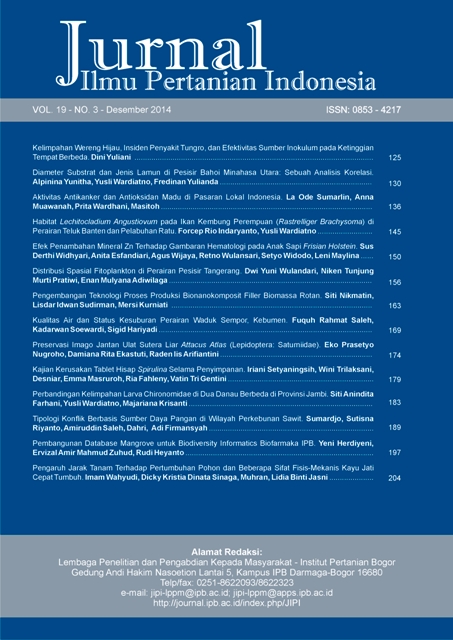Kualitas Air dan Status Kesuburan Perairan Waduk Sempor, Kebumen
Abstract
Sempor Reservoir is one of the reservoir in Central Java. This reservoir has primary function as irrigation and hydropower source. Beside, it also has some benefit for fisheries and tourism activities. Reservoir utilization which has not been optimum yet need some adjustments with water quality and aquatic trophic state in Sempor Reservoir. This study was aimed to determine water quality and aquatic trophic state of Sempor Reservoir. This study was conducted from January to March 2014 with monthly water sampling. Survey method to collect data with stratified random sampling was used for four represented station. Aquatic trophic state determination was based in Carlson Trophic State Index (TSI) measurement. This method used some represented parameters of physics, chemistry and biology such as water transparency, total phosphorus, and chlorophyll-a. The results showed that water quality of Sempor Reservoir was still good for fishery activities. Aquatic trophic state of Sempor Reservoir based on Carlson TSI was classified to low-medium in euthropic category ranging from 50.71-64.91. Inlet was the only area which had medium category of eutrophic due to highly nutrient content derived from anthropogenic activities nearby.
Downloads
References
American Public Health Association. 2005. Standard Methods for The Examination of Water and Wastewater. 21th Edition. American Public Health Assosiation/American Water Work Association/Water Enviroment Federation Washington. DC. (US): 1100 pp.
Carlson RE. 1977. A trophic state index for lakes. Limnology and Oceanography. 22(2): 361-369.
Fachrul MF. 2007. Metode Sampling Bioekologi. Bumi Aksara, Jakarta (ID).
Mulyanto. 1992. Lingkungan Hidup Untuk Ikan. Departemen Pendidikan dan kebudayaan, Jakarta (ID).
Murthy GP, Shivalingaiah, Leelaja BC, Shankar PH. 2008. Trophic State Index in Conservation of Lake Ecosystem. Proceeding of Taal2007: The 12th World Lake Conference: 840-843.
Novotny V, Olem H. 1994. Water quality, prevention, identification, and management of diffuse pollution. Van Nostrans Reinhold, New York (US).
Peraturan Menteri Lingkungan Hidup No. 28 2009. Daya Tampung Beban Pencemaran Air Danau dan /atau Waduk.
Peraturan Pemerintah No. 82. 2001. Pengelolaan Kualitas Air dan Pengendalian Pencemaran Air.
Pescod MB. 1973. Investigation of Rational Effluent Stream Standards for Tropical Countries. AIT. Bangkok (TH).
Pratiwi NTM, Enan A, Johan B, Majariana K, Oji H, Piska WK. 2007. Status Limnologi Situ Cilala Mengacu Pada Kondisi Parameter Fisika, Kimia, dan Biologi Perairan. Jurnal Perikanan (J Fish Sci) IX(1): 82-94.
Rifa’I RS, Pertagunawan K. 1983. Biologi Perikanan 1. Penerbit CV Kayago, Jakarta (ID).
Riyadi A. 2006. Kajian Kualitas Air Waduk Tirta Shinta di Kotabumi Lampung. Jurnal Hidrosfir. 1(2): 75-82.
Samuel, Siti NA, Safran M, Subagdja. 2010. Perikanan dan Kualitas Lingkungan Perairan Danau Ranau Dalam Upaya Pelestarian dan Mendukung Produksi Hasil Tangkapan Nelayan. Laporan Akhir Riset. Kementrian Kelautan dan Perikanan. BRPPU Palembang (ID).
Suryono T, Senny S, Endang M, Rosidah. 2010. Tingkat Kesuburan dan Pencemaran Danau Limboto Gorontalo. Oseanologi dan Limnologi di Indonesia. 36(1): 49-61.
Tusseau-Vuilleman MH. 2001. Do Food Processing Industries Contribte To The Eutrophication of Aquatic Systems? Ecotoxicol. Environmental Safety. 50(2): 143-152.
Vanni JM, Temte J. 1990. Seasonal pattern of grazing and nutrient limitation of phytoplankton in eutrophic lake. Limnology and Oceanography. 35(3): 697-709.
Wiryanto, Totok G, Tandjung SD, Sudibyakto. 2012. Kajian Kesuburan Perairan Waduk Gajah Mungkur Wonogiri. Jurnal EKOSAINS. IV(3): 1-10.
This journal is published under the terms of the Creative Commons Attribution-NonCommercial 4.0 International License. Authors who publish with this journal agree to the following terms: Authors retain copyright and grant the journal right of first publication with the work simultaneously licensed under a Creative Commons Attribution-NonCommercial 4.0 International License. Attribution — You must give appropriate credit, provide a link to the license, and indicate if changes were made. You may do so in any reasonable manner, but not in any way that suggests the licensor endorses you or your use. NonCommercial — You may not use the material for commercial purposes.


















